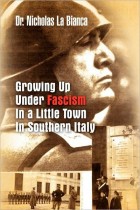Xlibris, $19.99, 254 pages
Remnants of Italy’s archaic feudal system remained when Mussolini became prime minister in 1922. By traditional standards, the author’s family was considered a lower middleclass family of landowners in their small southern village. La Bianca’s factual account is a glimpse of his life during the 1930s through the mid-40s–a taste of their labor-intensive culture, and his struggle to achieve an education in a society that normally sends children to work after they complete the fifth grade.
La Bianca’s father left Italy as a teenager to seek employment in America and was eventually drafted by the US military and served in WWI. Proud of his new patriotism, La Bianca’s father continued to work in America to support his family, but the author and his siblings remained in Italy with their mother until after WWII.
The author takes us on tour of the town, their small apartment, and the quaint Italian culture during a time of deprivation and devastation. He describes the olive and almond harvesting; the drying, storing, and pickling of winter foods; the games the children played without the luxury of toys; fleeing from frightening air raids to sleep in barns and happier times like religious celebrations and carnevales.
La Bianca gives Il Duce (Mussolini) his due for solving many of Italy’s problems, including sovereignty for the Vatican and vast infrastructure improvements, like public utilities and schools. The author also expands on the unnecessary carnage in southern Italy, due to poor military strategy by Allied Forces. After the war, his family relocates to America and La Bianca goes on to graduate school in New York and eventually earns a Doctor of Arts degree.
The informational value of this book is extraordinary—a precious resource for anyone researching Italian life during this period. However, it contains errors, and like most memoirs, the author’s voice occasionally seems detached. The numerous pictures, maps and illustrations help to clarify the descriptions and add flavor to the narrative.
Sponsored Book Review

